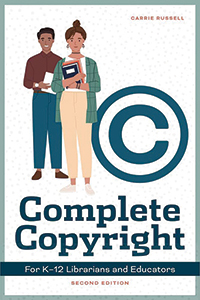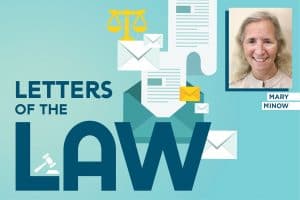
Why do librarians and teachers—the very professionals who specialize in information literacy, equitable access to information, and the advancement of learning—have so many anxieties and misconceptions about copyright?
Many of us harbor an unfounded fear of copyright litigation. “Better safe than sorry” is a frequent assertion. But that attitude can keep users and creators of copyright-protected content from engaging in personal and educational activities that are unlikely to infringe copyright law. That excess caution is, consequently, contrary to the values of librarianship, teaching, and the goals of copyright.
School librarians and teachers are not to blame for these uncertainties and fears. Copyright is barely mentioned in library school. Many copyright education materials targeted to K–12 librarians are wrong or woefully incomplete. And copyright law is complicated.
Part of librarians’ hesitancy to assert users’ rights to information comes from the school environment itself. Staffers are dedicated but spread thin, already overburdened with work, assignments, lesson plans, grading, and staff meetings. Moreover, school librarians are usually the sole librarian for their school, without other librarians around on a day-to-day basis to talk to about matters that come up such as copyright.
Digital formats add a layer of complexity. Copying and distributing digital content without authorization is easy and occurs all the time. It’s hard to understand when this is lawful and when it is not. Digital resources are generally governed by contracts or private agreements between parties that sidestep public policy considerations that Congress has included in copyright law.
One can argue that copyright no longer matters because rights holders now set the terms of use for digital content. (This can also apply to print materials, although it’s not typical.) But not talking about it would be an incredible disservice to the school community and the public at large. When licenses subvert key aspects of the law that support learning, education, and new creativity and scholarship, it’s up to us to do something about it.
To manage copyright effectively in your school, begin by understanding the purpose of the law. Learn basic concepts—exclusive rights, public domain, requirements for protection—and apply all available exceptions to the advantage of your school community. Make informed decisions but accept ambiguity and clear your mind of misinformation. Below I have outlined the top five copyright misconceptions to get you started.
Misconception one
Copyright law exists to ensure that authors and other creators are compensated monetarily for the works they create.
The US Constitution says that copyright law is created “to promote the progress of science and useful arts.” Its intent is, first and foremost, to encourage the creation and dissemination of original, creative works that benefit the public. These policies are also designed to advance public welfare by making works available that promote learning, inspire the creation of new works, produce well-informed citizens, and foster the pursuit of happiness.
To encourage the production of new works, Congress allows authors, creators, and other rights holders the legal right to a monopoly over the use of their works, with some limitations. This is realized by awarding a set of economic rights exclusively to the author or other rights holder. In the simplest of terms, rights holders have sole authority to market their work.
This is the bargain struck between members of the public, who require and enjoy access to information, and the author or rights holder, who seeks compensation for creating and disseminating protected creative works.
The notion that copyright law serves the public interest may sound quaint when much of the public discussion, and certainly much of political debate, is about copyright’s monetary value. While copyright does have an important economic value in the global information economy, the fundamental purpose of these laws is public welfare. Therefore, the values that underlie copyright law are completely consistent with the professional values of teachers and librarians.
The values that underlie copyright law are completely consistent with the professional values of teachers and librarians.
Misconception two
Rights holders sue libraries, teachers, and schools all the time.
Rest easy. Actual court cases involving libraries and schools are rare. People tend to believe that libraries and schools are frequently in legal trouble because they occasionally hear about schools that have been threatened with a lawsuit. Most of the time, the threat of a lawsuit is enough to make a school terminate an alleged infringement. A cease-and-desist letter and payment of a license fee do not mean copyright was infringed. Only a court can determine if a claim is indeed infringement.
Still, you may be worried about breaking the law and being held responsible for your actions or the actions of teachers or students. There are several reasons why these fears may be unwarranted.
First, because copyright law ultimately seeks to benefit the public, using protected works for teaching, research and scholarship, and learning is favored under the law. These socially beneficial uses are often reflected in the law as exceptions—limitations on the rights of the copyright holder that allow the public or certain entities the right to use a work in ways that would otherwise be infringement. These limitations are necessary because they aid in containing the copyright monopoly that Congress created. If that monopoly was all-encompassing, the purpose of the law—to advance learning and culture for the public’s welfare—could not be achieved.
Socially beneficial uses tend to occur more frequently in libraries, schools, and institutions of higher education because these are places where learners gather and knowledge is shared. These entities (occasionally along with archives, museums, historical societies, and other cultural institutions) hold special status under the law in that more limitations are created by Congress to address their unique need to serve the public, provide equitable access to information, and preserve the cultural record.
Second, in the unlikely event that a school or library is taken to court for alleged infringement, the rights holder cannot expect to win a large monetary award. Congress has set up special limits on penalties that are set at trial if a school or library is found to have infringed copyright.
Finally, public educational institutions and libraries are protected by the Eleventh Amendment to the US Constitution, which protects a state entity from being sued in a federal court without its consent. Again, this places a limit on the amount that rights holders could expect to collect if they sue schools or libraries.
Misconception three
Copyright-protected works are the property of their creators or rights holders.
People are often confused or are led to believe that copyright law is the same as property law. This confusion is compounded by terms such as intellectual property, which is a misnomer. Instead, copyright law resembles government regulation in that Congress creates the law to intervene in the market by granting rights holders a monopoly—via exclusive rights of copyright—to achieve a public purpose.
Assuming that copyright is a form of property law can lead to the misconception that creative works are owned by rights holders and therefore any unauthorized use of their “property” is forbidden. Copyright law instead says creators have exclusive rights to market their work. Only by distributing this work to others does it have any value, which is economic value for the rights holder.
This in turn leads to the use of words like stealing and piracy when the correct term for violating the copyright law is infringement. This distinction is important because we immediately understand that stealing is immoral and wrong, while some kinds of uses of works without the authority of the rights holder are lawful and indeed necessary to promote the progress of science and useful arts.

Creative works are also distinctive in that they cannot be depleted. If one person uses them, others can continue to use them. The term used to describe this is nonrivalrous, because there is no economic rivalry between would-be users. Moreover, it is difficult to exclude others from the use of a work after its first use. The public will continue to benefit from the work so long as there is still an original to use.
Economists say that these traits—nonrivalry and nonexclusivity—are characteristics of public goods. When I listen to music, I do not consume music in the same way that I consume an apple. The music is still available to anyone else to listen to, while the apple has been eaten up.
Another trait of creative works is that they gain value the more they are used. The more information is shared and used, the more knowledgeable people become, and the more new knowledge is created. These distinctions are not just mere curiosities. They help us better understand the benefit of creative works to the public.
Misconception four
There is a set of legal rules that offer definitive answers to copyright questions.
Many librarians and teachers find it vexing that there are no clear-cut rules. Often the answer to a specific copyright query requires analyzing the situation at hand to make a determination of fair use. Vexing, perhaps—but it is in our best interests to have ambiguity in the law. To set copyright rules in stone would be to freeze the law. The law must be malleable to serve our society now and in the future—a future that we can only speculate about. Fair use will serve us well because it is open to new technologies.
Some legal exceptions—like Section 108 (library reproductions) or Section 110 (public performances for educational and other purposes) in the federal Copyright Act of 1976—are more definite than fair use. If your use falls within these exceptions, it is almost always permitted. However, these exceptions are relatively rigid and don’t necessarily address all situations that may confront a librarian or teacher.
Section 108 addresses preservation, replacement, interlibrary loan, and copies of works for library users—but it doesn’t address when you can reproduce an image from the internet for your library homepage. It doesn’t address whether you can make a reproduction for a student who is learning English as a second language. It doesn’t address whether you can make a copy of a page from a book to replace a missing page in your damaged copy. You get the idea.
To be an effective librarian or teacher dealing with copyright requires that you bite the bullet, learn and apply the factors of fair use, and accept (and maybe appreciate) the law’s gaps. It is a strength of our copyright law that it has both clear and flexible exceptions.
Misconception five
Fair use is too difficult to understand and apply.
Not so. Once you learn the four factors of fair use (purpose of the use, nature of the publication, amount used, and effect on the market for the work), making a fair use determination comes more naturally, although it is never definitive.
A court of law makes the final call on whether a use is fair or not, but because we aren’t in litigation over every case of use, we must learn to make our own decisions, even when we cannot be absolutely certain that we are correct. It is our professional responsibility to understand fair use because our role is to facilitate access to and the use of information.
As previously mentioned, librarians are not to blame for having misconceptions about copyright. Information distributed over the years has been wrong or incomplete, and often conflicting. Even the American Library Association’s educational materials produced in the 1980s and 1990s misdirected librarians to focus on guidelines rather than a full understanding of the law.
But you do not have to have a law degree to conclude that a use is fair. Your underlying commitment to the public is to ensure that its rights are fully explored. Fair use is the best way to balance user rights with the interests of rights holders.


